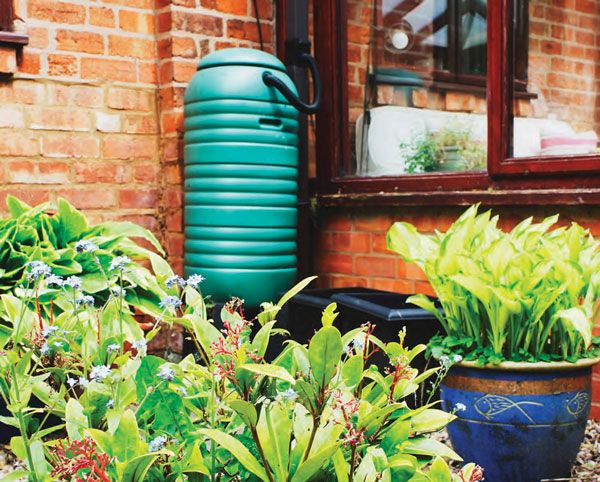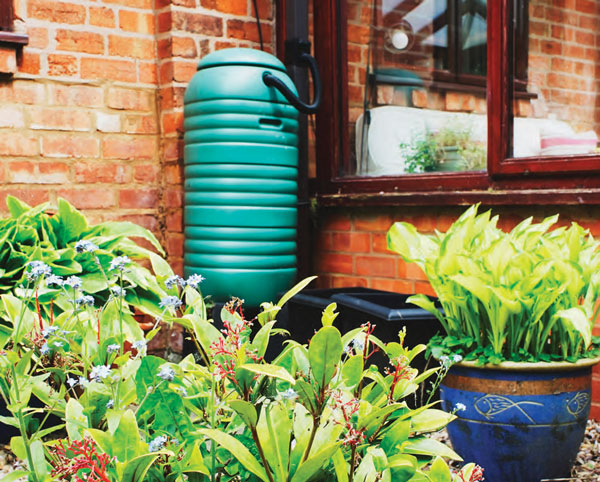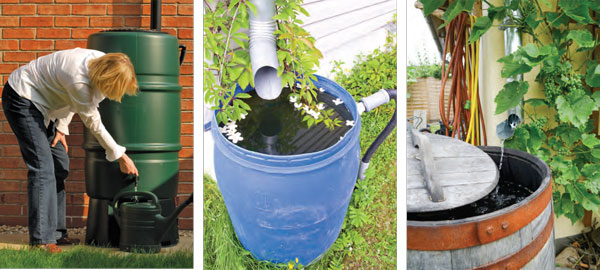Water Works | Collect Rain for Garden Use


Are you looking for a way to make both your yard and wallet greener? Make a small investment in a rain barrel, a savings-savvy and eco-friendly resource for your home. With a rain barrel, you can harness the power of free rainwater to reduce your monthly water bill and increase the health of your home, garden and community.
Rain barrels are sizable cisterns that connect to a downspout on your home. When it rains, water is filtered down into the rain barrel and contained for reuse. Homeowners can use the rainwater for many different outdoor tasks, like watering plants and washing cars.
The practice of collecting rainwater dates back 4,000 years and has stood the test of time for good reason. Environmentally, homeowners who use rain barrels conserve water and reduce runoff. Runoff water picks up pesticides, oils, fertilizers, and other pollutants that contaminate local water sources and can harm plants and animals.
Financially, homeowners can benefit by reducing their monthly water bill. Instead of using metered tap water from their hose in the hot summer months, rain barrel users make use of collected rainwater which would have otherwise gone to waste.

Options, features and capacity
There are many options, sizes and features to consider when shopping for a rain barrel. First, consider capacity. The amount of rainwater you will collect is determined by the size and design of your roof. One inch of rainfall can lead to a collection of approximately half a gallon of rainwater per square foot of your roof’s surface area. Think about the area of the roof near the connecting downspout when making estimations.
Be sure to protect your rainwater from insects, leaves, and small animals with a debris screen. Mosquitos can be particularly pesky, so remember to seal any gaps or tears in the screen or barrel to prevent them from laying eggs in or near your collection system.
Another thing to consider is how you would like to access your rainwater. A closed top will prevent animals and small children from reaching the water. However, if you would like to be able to fill a watering can by dipping it into your rainwater, a lid that opens or can be removed may be the best option for you, as long as the lid can be securely latched. Also, choose whether you would like to use a spigot or a hose connection to release your rainwater. When building or buying your rain barrel system, select features that offer convenience and suit your watering habits.
Setting up and locating your system
Before installing a rain barrel, check local regulations and make sure that you are in compliance with municipal ordinances. Inspect your gutters to ensure that they are clear and in working order. When you are ready to install your collection system, select a downspout from your gutter system to connect to the rain barrel. Set up your rain barrel in an area that needs water and can tolerate overflow in the event of heavy rains.
Some rain barrels connect directly to a gutter for easy collection. Flat-back barrels sit close to the wall of your home, so downspouts may need less modification with this type of model. If you plan to use a barrel with a spigot, make sure that the spigot directs the water away from the foundation of your home.
Use and maintenance
Use rainwater within one or two weeks after a rainfall to reduce odors and minimize the growth of algae and bacteria in your rain barrel. If you do not plan to use your rainwater shortly after collection, perhaps if you are away from home, keep the spigot open to release the water. Disconnect the downspout if you plan to be away or if you do not plan to collect water for an extended period of time.
When using a rain barrel, remember that rainwater is untreated, so it should not be used as drinking water for people or pets. During harvest season, be sure to wash all of your produce with tap water before consumption.
Regularly inspect the rain barrel for leaks. Pay attention to the maintenance recommendations in your user’s manual if you purchase a unit. Some instructions encourage users to always keep some water in the barrel to hold it in place. Rinse out sediment from the barrel that breaches the debris screen to ensure your water is clean. Before freezing weather arrives, disconnect, empty, and store your rain barrel. Certain models have a collapsible design for easy storage. Thoroughly clean out your barrel before storing it for the winter, and remember to reset your gutter or downspout to divert water from your roof.
No matter what size or type of rain barrel you settle on, you can feel confident that you are helping the environment and saving money. Visit your local hardware store to inquire about building or buying a rain barrel, and prepare to reap the benefits of a practice that has delivered sustainability through the ages. ✦
capacity, collection system, Flat-back barrels, garden, rain barrels, rainwater






